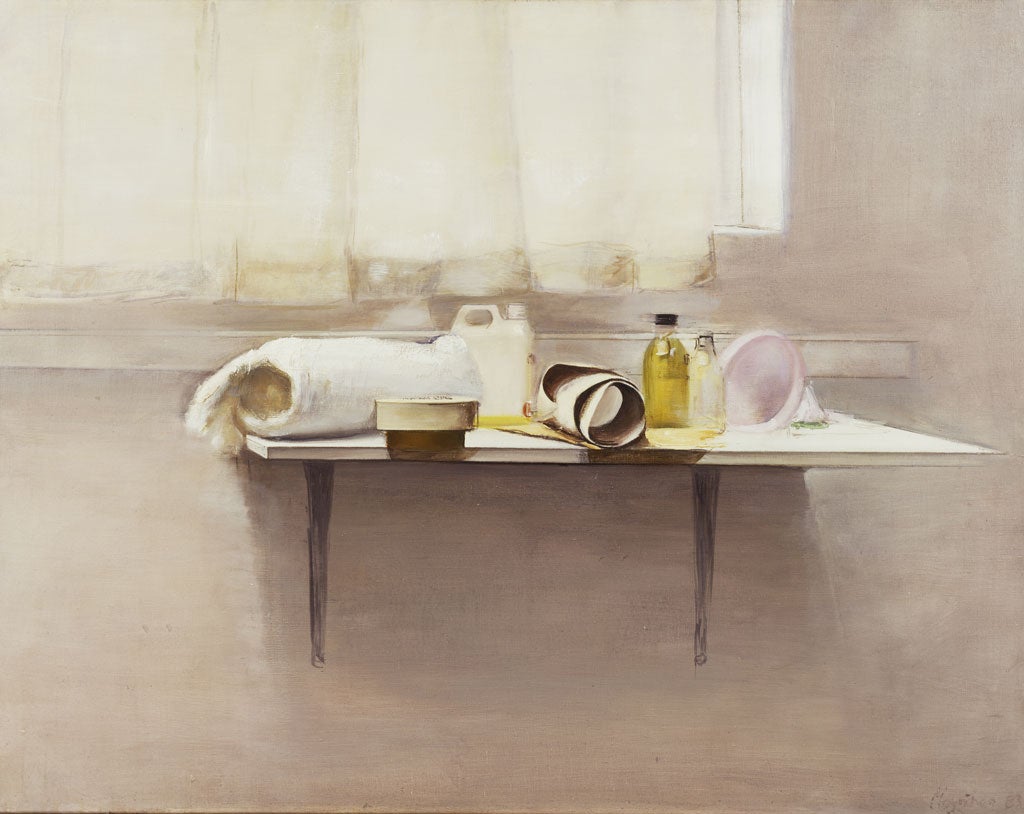Great Works: The Shelf: Objects and Shadows – Front View, 1982-83 (71.1cm x 91.5cm) by Rodrigo Moynihan
Tate, London

To an artist, there is nothing more precious than his studio. It is his birthing suite and his retirement home. Francis Bacon's was a creative maelstrom. It looked like a scene of warfare, carnage. It was where, by sheer force of will, he fought his pitched battles against rage, despair, frustration.
Stanley Spencer painted a great work called Christ in the Wilderness in a poky little dive in Swiss Cottage. That studio was a nothing kind of a space. "Among two chairs, a bed and a chair," Spencer wrote, "I was as it were in a wilderness." And, little by little, Christ kept him company him there. Other artists, often the more prosperous ones, used their studios as sites of self-display. They painted themselves working there, strutting, self-preening, amid lush draperies and a clutter of silverware, as they entertained potential clients.
Rodrigo Moynihan's way is rather different. We are in his place of making, and yet there is nothing of himself to be seen here, and no sight of any of his finished paintings either. He is the absent presence, the ghost in the machine. What we have instead, within this sparely furnished corner beside a window which has been blanked out by a thin curtain or blind – it is not clear which – is a mellow, gauzy light that seems to sanctify, raise up the humble objects of his trade as a painter of such an absorbing still life as this one: the bottle of linseed oil, that plastic bottle of PVA glue, the turps, the rolled-up canvas which curls heavily about itself, the more loosely rolled and unruly paper, and what may be a couple of books that we see side-on, projecting out at us.
The fact that we cannot see beyond and out makes us attend to what he has to show us all the more, and to contemplate its significance: it is from such things as these that he creates what you are staring at now, this painting, whose very subject is the modesty of the artist's means. It would have been quite different if, as often happens in paintings by Freud, for example, you could have seen a distracting context of roof tops, gardens, fragments of urbanscape. The fact that none of this is there, with its alternative sources of colour and shapeliness, means that this fragment of a studio draws in on itself, and encourages us to see it as if almost afloat within the space of the painting. Yes, does all this not amount to a miracle of sorts?
The entire scene seems to hang suspended, hushed, in the warmth of its gathered light, which has a certain understatedly soft, nourishing peachiness to it. The dominant tones seem to spill, bleed across from object to object – see how the yellow at the base of the curtain rhymes with the yellowness of the linseed oil, and how that in turn seems to carry over to the yellow of the rolled end of canvas. This light, which seems to bear and offer up the scene to us, also deals reverentially with the perfectly average shelf which projects out from the wall, held up by a pair of modest metal brackets. The shelf seems to say: it is from here, this plain, flat, cluttered surface of formica, that paintings are made. The individual objects tease us slightly. They seem both sharply defined and a touch indefinite, simultaneously. The title too intrigues, its matter-of-factness, its suggestion that this is nothing more than a rather painstaking academic study, squared up, carefully measured with the eye, a slice of documentation. In fact, all these objects have a wonderful resonance, and the painting itself is almost closetedly religious in its atmosphere.
About the artist
Rodrigo Moynihan (1910-90) was a British painter born in the Canary Islands. His mother was Spanish. He studied at the Slade with William Coldstream, and he was associated with different groupings of painters at different moments in his career: the Euston Road School, the London Group, and the Objective Abstraction group. His best works consist of large-scale portrait groups, still lifes, and various adventures in abstraction.
Subscribe to Independent Premium to bookmark this article
Want to bookmark your favourite articles and stories to read or reference later? Start your Independent Premium subscription today.

Join our commenting forum
Join thought-provoking conversations, follow other Independent readers and see their replies